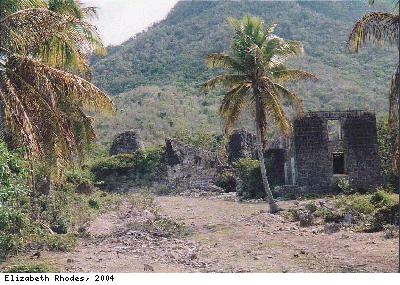The Island of Nevis
Sugar and Sugar Plantations
Sugar is still grown on the island of St Kitts where there are 30 large estates as well as smallholders growing cane. All that remains of the industry on Nevis are the ruins of plantation houses and sugar works, such as steam driven cane crushers and huge bowls, called coppers, which were used for boiling up the juice. Many of the former plantation houses have been converted into hotels with historic décor and impressive grounds.
Many atmospheric places remain where echoes of a time long gone drift through the sunlight. There are ruined plantation houses far away from existing roads, stone-built bridges now apparently linking nowhere to nowhere and chimneys rising out of the undergrowth. The picture shows all that remains of the Nisbet Plantation.
Jungle vegetation has crept back, completely hiding crumbling stone ruins which could have given up their secrets. Little hard evidence remains about plantation life and the homes of the enslaved people from the late 17th and early 18th century. Hurricanes, raids by invading French armies and earthquakes have destroyed original wooden houses and artefacts. Torrential storms washed pottery and metal items down the steep slopes to the beaches or into the sea.
The sugar industry gradually declined. Soils became impoverished from heavy cropping and intensive farming moved to other islands in the Caribbean. Other countries took over production during the early 20th century. In the 1950s the last sugar factory on Nevis ceased production.
The sugar estates and sugar factory on St Kitts were taken into state ownership in 1975.
Sugar has mostly been replaced by tourism and light industry. Today manufacturing on St Kitts and Nevis is based at four industrial estates, one of which is on Nevis. Export products include electronics and data processing equipment and garment manufacturing for the US market. Other small enterprises include food processing.

 Nevis, ‘Our Lady of the Snows’
Nevis, ‘Our Lady of the Snows’ People and Places
People and Places Earliest settlers
Earliest settlers The arrival of the Europeans
The arrival of the Europeans Arriving on the Island today
Arriving on the Island today Education
Education Young People on the Island
Young People on the Island Government
Government Sugar and Sugar Plantations
Sugar and Sugar Plantations Churches and Religion
Churches and Religion

